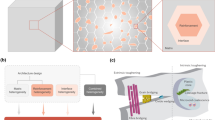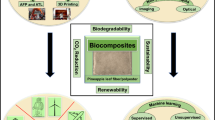Abstract
Synergistic damage mechanics (SDM) is a multiscale approach to predict the transverse-cracks effect on the composite laminates engineering moduli. Decreasing experiments needed for calibrating the model, the SDM considerably reduces the design cost. Despite the advantages, the method has not been applied to fiber-metal laminates (FML). While the FMLs undergo plasticity damage because of the metal layers, the SDM has been only developed for fibrous, polymeric composites that do not have plastic behavior; As such, the approach needs to be developed to consider the plasticity before implementation in FMLs. In this paper, SDM is developed to predict the stiffness degradation and elastoplastic behavior of the FMLs with transverse-cracks and plasticity damages. Subsequently, three independent models based on the developed approach are proposed to case study an aluminum/glass/epoxy FML. Then, each model is separately analyzed mathematically, and the equations of engineering moduli are derived. The models are calibrated using a finite-element (FE) micromechanical model of a reference laminate. Then, the SDM models are validated with a recently introduced modified in situ digital microscopy accompanied by the quasi-static loading–unloading test and the FE micromechanical model of the FML. Relating the unknown plastic behavior of the FML to the known plastic behavior of its metal layers, the best SDM model is further developed to predict the stress–strain diagram of the FML and validated with the tension tests.






















Similar content being viewed by others
References
Bonora N (1997) A nonlinear CDM model for ductile failure. Eng Fract Mech 58:11–28
Talreja R, Singh CV (2012) Damage and failure of composite materials. Cambridge University Press
Ghajar R, Khalili S, Yarmohammad Tooski M, Alderliesten R (2015) Investigation of the response of an aluminium plate subjected to repeated low velocity impact using a continuum damage mechanics approach. Fatigue Fract Eng Mater Struct 38:475–488
Shajari AR, Ghajar R, Shokrieh MM (2018) Multiscale modeling of the viscoelastic properties of CNT/polymer nanocomposites, using complex and time-dependent homogenizations. Comput Mater Sci 142:395–409
Keshavarz A, Ghajar R (2019) Effect of isotropic and anisotropic damage and plasticity on ductile crack initiation. Int J Damage Mech 28:918–942
Türtük İ, Deliktaş B (2016) Coupled porous plasticity–continuum damage mechanics approaches for modelling temperature driven ductile-to-brittle transition fracture in ferritic steels. Int J Plast 77:246–261
Park J, Lee K, Kang J-H, Kang J-Y, Hong S, Kwon S et al (2021) Hierarchical microstructure based crystal plasticity-continuum damage mechanics approach: Model development and validation of rolling contact fatigue behavior. Int J Plast 143:103025
Cano JA, Stewart CM (2021) A continuum damage mechanics (CDM) based Wilshire model for creep deformation, damage, and rupture prediction. Mater Sci Eng, A 799:140231
Mohammadi B, Shokrieh M, Jamali M, Mahmoudi A, Fazlali B (2021) Damage-entropy model for fatigue life evaluation of off-axis unidirectional composites. Compos Struct 270:114100
Karimi M, Ghajar R, Montazeri A (2018) A novel interface-treated micromechanics approach for accurate and efficient modeling of CNT/polymer composites. Compos Struct 201:528–539
Leclerc J, Nguyen V-D, Pardoen T, Noels L (2020) A micromechanics-based non-local damage to crack transition framework for porous elastoplastic solids. Int J Plast 127:102631
Guo Q, Zaïri F (2021) A micromechanics-based model for deformation-induced damage and failure in elastomeric media. Int J Plast 140:102976
Fesahat M, Vafaeenezhad H, Esnaashary M, Yazdi A, Hosseinabadi F, Soltanieh M (2021) A micromechanical approach to deformation and damage of nickel foam used in conductive layer of lithium-ion battery. Mater Sci Eng, A 825:141895
Farrokhabadi A, Bahrami M, Babaei R (2019) Predicting the matrix cracking formation in symmetric composite laminates subjected to bending loads. Compos Struct 223:110945
Talreja R (1996) A synergistic damage mechanics approach to durability of composite material systems. In: Progress in durability analysis of composite systems, pp 117–129
Talreja R (1998) Further development of a synergistic damage mechanics approach for composite materials. In: Proceedings of the eighth Japan-US conference on composite materials. CRC Press, pp 258–262
Talreja R (2006) Multi-scale modeling in damage mechanics of composite materials. J Mater Sci 41:6800–6812
Talreja R (2006) Damage analysis for structural integrity and durability of composite materials. Fatigue Fract Eng Mater Struct 29:481–506
Talreja R (2008) Damage and fatigue in composites–a personal account. Compos Sci Technol 68:2585–2591
Varna J, Joffe R, Akshantala N, Talreja R (1999) Damage in composite laminates with off-axis plies. Compos Sci Technol 59:2139–2147
Varna J, Joffe R, Talreja R (2001) A synergistic damage-mechanics analysis of transverse cracking in [±θ/904] s laminates. Compos Sci Technol 61:657–665
Varna J, Akshantala NV, Talreja R (1999) Crack opening displacement and the associated response of laminates with varying constraints. Int J Damage Mech 8:174–193
Varna J, Krasnikovs A, Kumar RS, Talreja R (2004) A synergistic damage mechanics approach to viscoelastic response of cracked cross-ply laminates. Int J Damage Mech 13:301–334
Singh CV, Talreja R (2008) Analysis of multiple off-axis ply cracks in composite laminates. Int J Solids Struct 45:4574–4589
Singh CV, Talreja R (2009) A synergistic damage mechanics approach for composite laminates with matrix cracks in multiple orientations. Mech Mater 41:954–968
Li S, Singh CV, Talreja R (2009) A representative volume element based on translational symmetries for FE analysis of cracked laminates with two arrays of cracks. Int J Solids Struct 46:1793–1804
Singh CV, Talreja R (2010) Evolution of ply cracks in multidirectional composite laminates. Int J Solids Struct 47:1338–1349
Singh CV, Talreja R (2013) A synergistic damage mechanics approach to mechanical response of composite laminates with ply cracks. J Compos Mater 47:2475–2501
Singh CV (2013) A higher order synergistic damage model for prediction of stiffness changes due to ply cracking in composite laminates. CMC: Computers & Materials:227–49
Haojie S, Weixing Y, Yitao W (2014) Synergistic damage mechanic model for stiffness properties of early fatigue damage in composite laminates. Procedia Engineering 74:199–209
Montesano J, Singh CV (2014) Progressive failure analysis of polymer composites using a synergistic damage mechanics methodology. In: Advanced composites for aerospace, marine, and land applications. Springer, pp 147–155
Montesano J, Chu H, Singh CV (2016) Development of a physics-based multi-scale progressive damage model for assessing the durability of wind turbine blades. Compos Struct 141:50–62
Zuo Y, Montesano J, Singh CV (2018) Assessing progressive failure in long wind turbine blades under quasi-static and cyclic loads. Renew Energy 119:754–766
Montesano J, Singh CV (2015) A synergistic damage mechanics based multiscale model for composite laminates subjected to multiaxial strains. Mech Mater 83:72–89
Montesano J, Singh CV (2015) Predicting evolution of ply cracks in composite laminates subjected to biaxial loading. Compos B Eng 75:264–273
Montesano J, Singh CV (2016) Critical stiffness damage envelopes for multidirectional laminated structures under multiaxial loading conditions. Mater Des 91:218–229
Berton T, Haldar S, Montesano J, Singh CV (2018) Time-dependent damage analysis for viscoelastic-viscoplastic structural laminates under biaxial loading. Compos Struct 203:60–70
Montesano J, McCleave B, Singh CV (2018) Prediction of ply crack evolution and stiffness degradation in multidirectional symmetric laminates under multiaxial stress states. Compos B Eng 133:53–67
Berton T, Montesano J, Singh CV (2016) Development of a synergistic damage mechanics model to predict evolution of ply cracking and stiffness changes in multidirectional composite laminates under creep. Int J Damage Mech 25:1060–1078
Berton T, Najafi F, Singh CV (2019) Development and implementation of a multi-scale model for matrix micro-cracking prediction in composite structures subjected to low velocity impact. Compos B Eng 168:140–151
Pao WY, Haldar S, Singh CV (2020) Performance analysis of composite helicopter blade using synergistic damage mechanics approach. AIAA J 58:968–976
Ghajar R, Ghadami M (2023) A novel experimental method and computational micromechanical model for in-situ damage detection and prediction of stiffness degradation in cross-ply FML. Compos Struct 305:116492
Kashfi M, Majzoobi G, Bonora N, Iannitti G, Ruggiero A, Khademi E (2019) A new overall nonlinear damage model for fiber metal laminates based on continuum damage mechanics. Eng Fract Mech 206:21–33
Christensen RM (1988) Tensor transformations and failure criteria for the analysis of fiber composite materials. J Compos Mater 22:874–897
Murakami S (2012) Continuum damage mechanics: a continuum mechanics approach to the analysis of damage and fracture. Springer, Berlin
Lemaitre J, Desmorat R (2006) Engineering damage mechanics: ductile, creep, fatigue and brittle failures. Springer, Berlin
Funding
The authors declare that they have no known non-financial interests that could have appeared to influence the work reported in this paper.
Author information
Authors and Affiliations
Corresponding author
Ethics declarations
Conflict of interest
The authors declare that they have no known competing financial interests that could have appeared to influence the work reported in this paper.
Additional information
Technical Editor: João Marciano Laredo dos Reis.
Publisher's Note
Springer Nature remains neutral with regard to jurisdictional claims in published maps and institutional affiliations.
Appendix A
Appendix A
The following Appendix presents derived equations from the theoretical analysis of the proposed polynomial functions. The procedure to derive these equations is almost the same as described in Sect. 6.1. So, only the derived equations are presented.
1.1 A.1: The second-order model formulae
For the proposed second-order Helmholtz function of Eq. (32), the following equations are derived to predict the engineering moduli:
where \({\kappa }_{nm}{a}_{inm}\) and \({{\kappa }_{nm}^{2}b}_{inm}\) are eight damage constants that need to be obtained. The following equations are needed for this goal:
In the case of the second-order function, two reference states of cross-ply glass/epoxy damage are needed. Taking the parameters \({\kappa }_{nm}{a}_{inm}\) and \({{\kappa }_{nm}^{2}b}_{inm}\) as the unknowns \({x}_{i}\) and \({y}_{i}\) for simplicity, Eqs. (41–44) are a general form of Eq. (45):
Substituting two reference states of \(s={s}_{1}\) and \(s={s}_{2}\), a system of eight linear equations is generated:
which can be simplified in a matrix form:
where:
The solution to the system of equations is as follows:
1.2 A.2: The third-order model formulae
The appropriate derived equations of engineering moduli from the proposed third-order Helmholtz function of Eq. (33) are as follows:
where \({\kappa }_{nm}{a}_{inm}\), \({{\kappa }_{nm}^{2}b}_{inm}\), and \({{\kappa }_{nm}^{3}f}_{inm}\) are 12 damage constants that need to be obtained using three reference states of damage for the glass/epoxy laminate and the following equations:
Equations (55–58) are a general form of Eq. (59):
which is a system of 12 linear equations. The system can be solved through a similar procedure described in Sect. A.1 and Eqs. (46–50).
Rights and permissions
Springer Nature or its licensor (e.g. a society or other partner) holds exclusive rights to this article under a publishing agreement with the author(s) or other rightsholder(s); author self-archiving of the accepted manuscript version of this article is solely governed by the terms of such publishing agreement and applicable law.
About this article
Cite this article
Ghajar, R., Ghadami, M. Synergistic damage mechanics development to predict elastoplastic behavior of an Al/GE laminate with transverse-cracks and plasticity damages. J Braz. Soc. Mech. Sci. Eng. 45, 406 (2023). https://doi.org/10.1007/s40430-023-04308-5
Received:
Accepted:
Published:
DOI: https://doi.org/10.1007/s40430-023-04308-5




